Southampton
On Tuesday, Kathy and Tristan went off to Salisbury and Stonehenge, which I've already visited twice, so I decided to stay, work on my diary, and explore a little of Southampton. On the way back from breakfast, I dropped into Marks and Spencer to buy some cherries and peaches, which served to remind me that France isn't the only country that doesn't put up with the miserable fruits and vegetables you can buy at Publix. No luck finding a European bird-song instructional CD, though, at either a music store or a nature store.
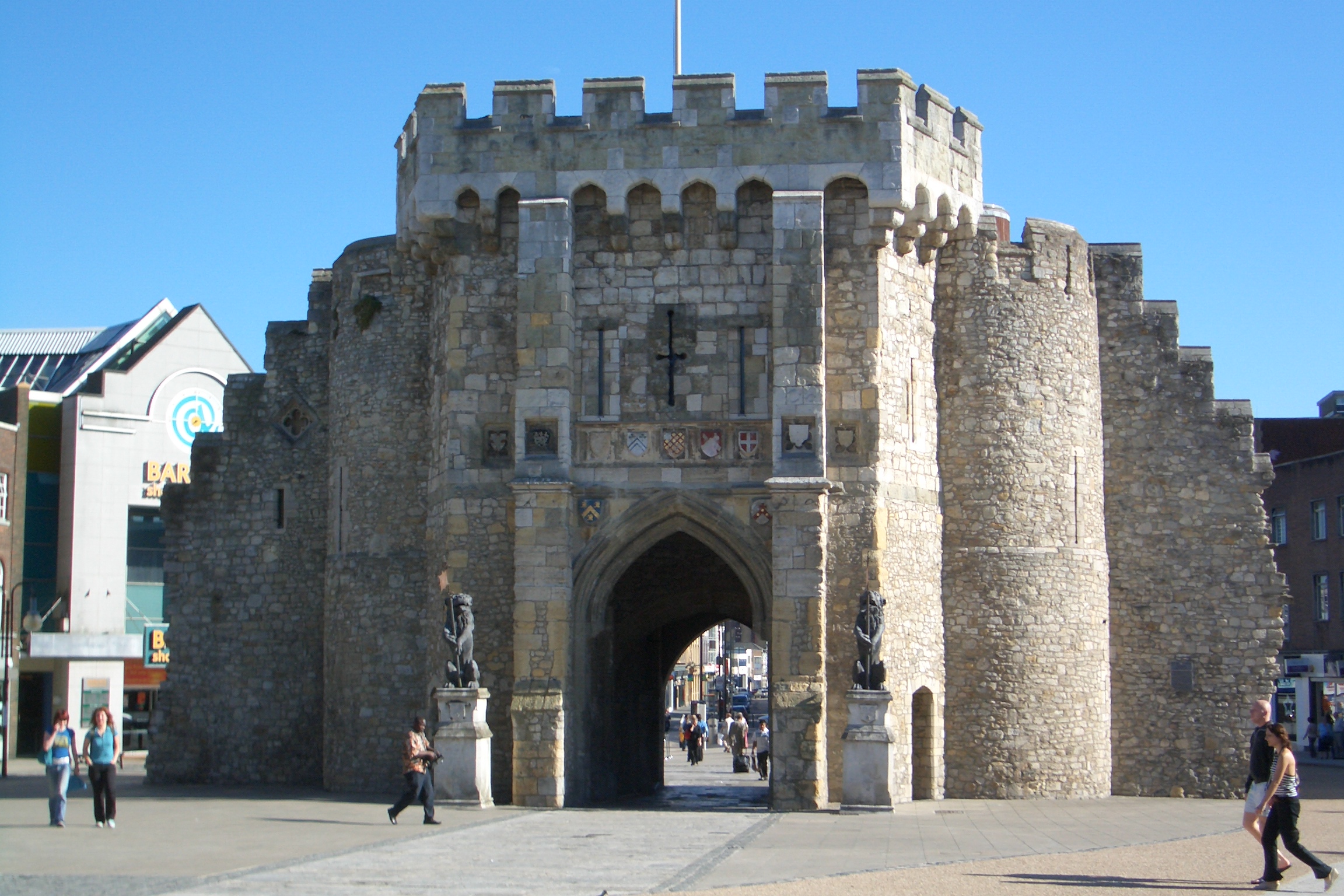 During the afternoon, I walked part of the old Southampton city walls, almost half of which are still standing (in isolated segments of various lengths). Southampton was built on the peninsula between the rivers Itchen and Test, where they meet to form Southampton Water (the estuary that in turn empties into the Solent, the strait between the mainland and the Isle of Wight). The walled city was roughly rectangular, its long axis running north and south. I started at the Bargate, originally in the middle of the landward end. It now marks the spot at which the pedestrian High Street (within the old town) becomes the traffic-bearing Above Bar Street (north of the old town). This view is of the north (outward) face of the gate. To the right of the picture, a set of modern stairs leads to the walkway along the top of the walls, where this statue of John le Fleming (1295-1336), an early mayor of the city, looks northward over the wall.
During the afternoon, I walked part of the old Southampton city walls, almost half of which are still standing (in isolated segments of various lengths). Southampton was built on the peninsula between the rivers Itchen and Test, where they meet to form Southampton Water (the estuary that in turn empties into the Solent, the strait between the mainland and the Isle of Wight). The walled city was roughly rectangular, its long axis running north and south. I started at the Bargate, originally in the middle of the landward end. It now marks the spot at which the pedestrian High Street (within the old town) becomes the traffic-bearing Above Bar Street (north of the old town). This view is of the north (outward) face of the gate. To the right of the picture, a set of modern stairs leads to the walkway along the top of the walls, where this statue of John le Fleming (1295-1336), an early mayor of the city, looks northward over the wall.
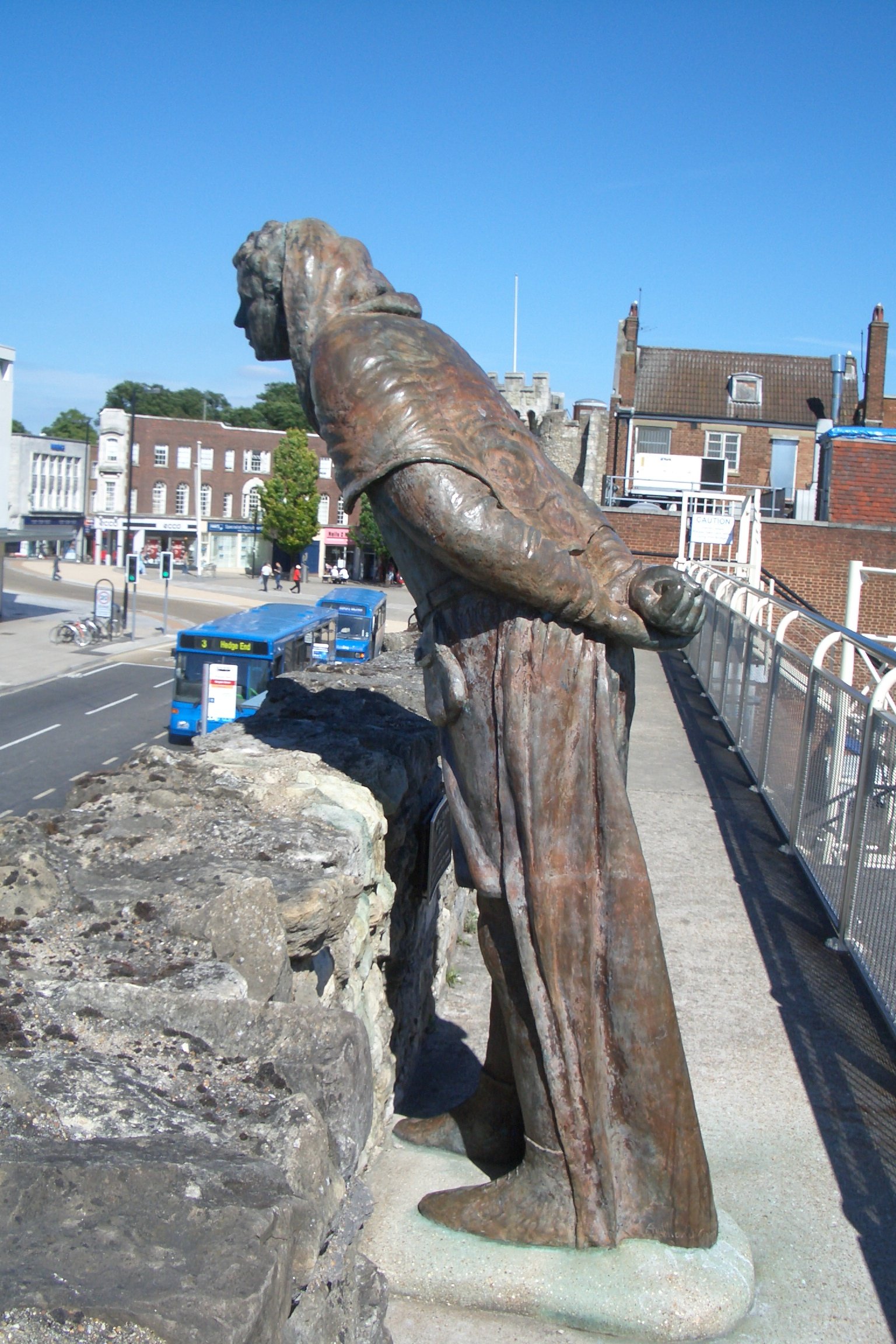
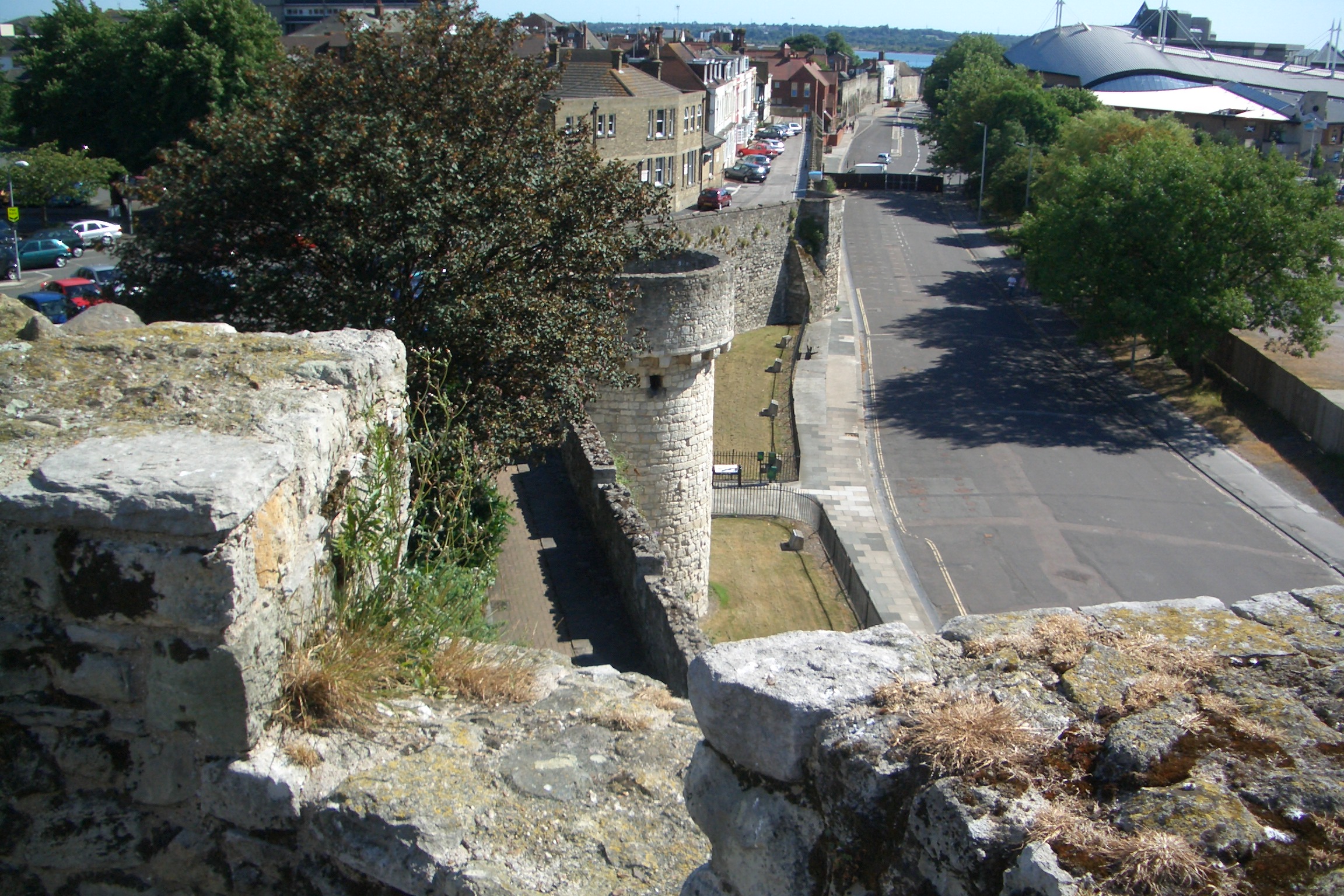 The western stretch of the wall is the most complete. In this photo from the tower at the northwest corner, you can see it stretching away parallel to the road until it disappears around the curve in the distance.
The western stretch of the wall is the most complete. In this photo from the tower at the northwest corner, you can see it stretching away parallel to the road until it disappears around the curve in the distance.
About that point, a replica clinker-built Medieval cargo boat has been embedded in the sidewalk for close examination. "Clinker-built" means that the planks forming its hull overlap one another rather than being fitted sawn-edge to sawn-edge as in later construction. In the middle ages, Southampton traded widely but most frequently with Bordeaux. The boat is wide and deep-bellied and could carry, e.g., wine in bottles or barrels, live stock, wool, or lumber. The popularity of "claret"—red Bordeaux wine—dates from that period. The word "claret" actually derives from the French "clairet," a "light-red" wine still made in the Bordeaux area. It's intermediate between rosé and a true red, and David got to taste it during our afternoon bus tour of Entre Deux Mers.
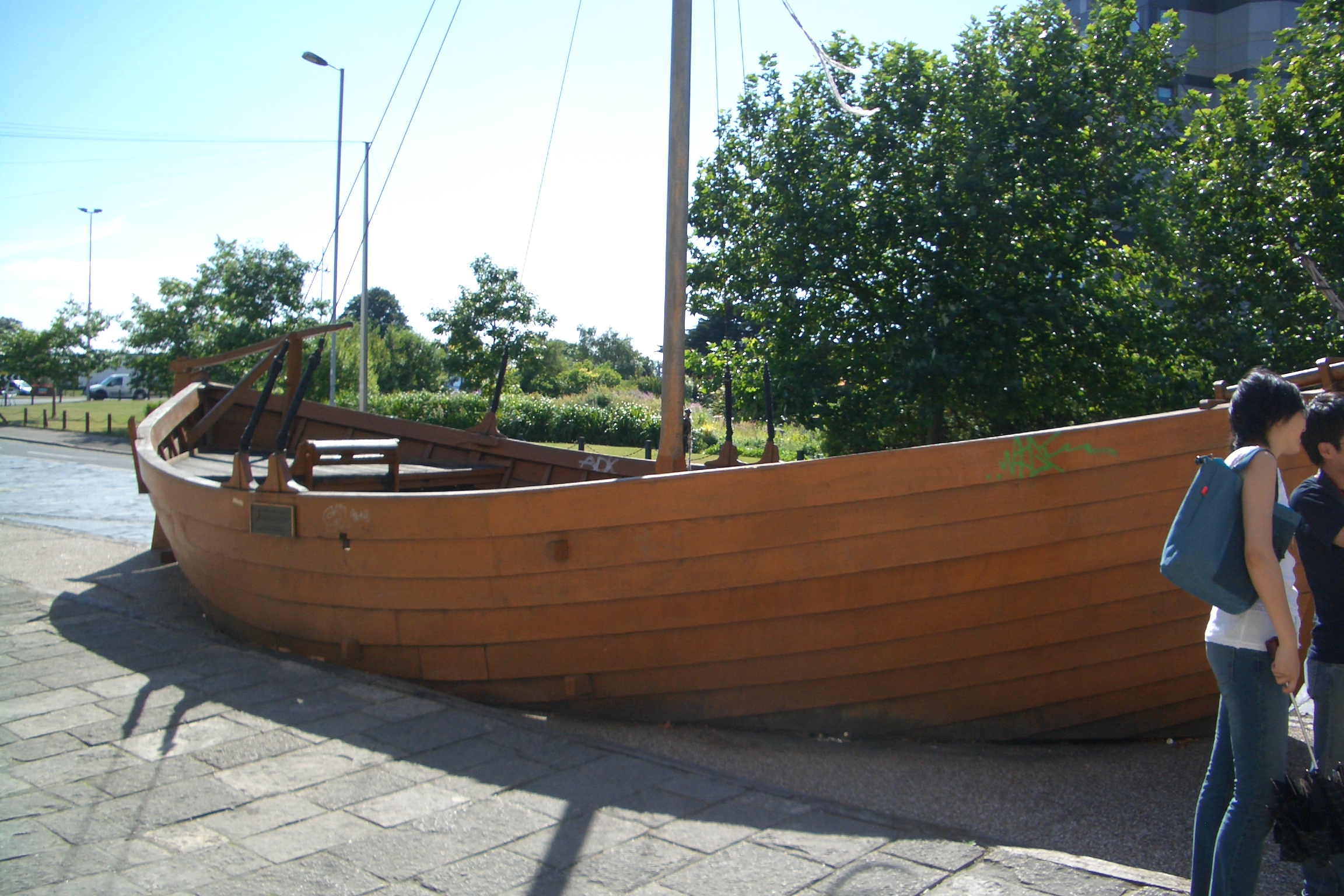
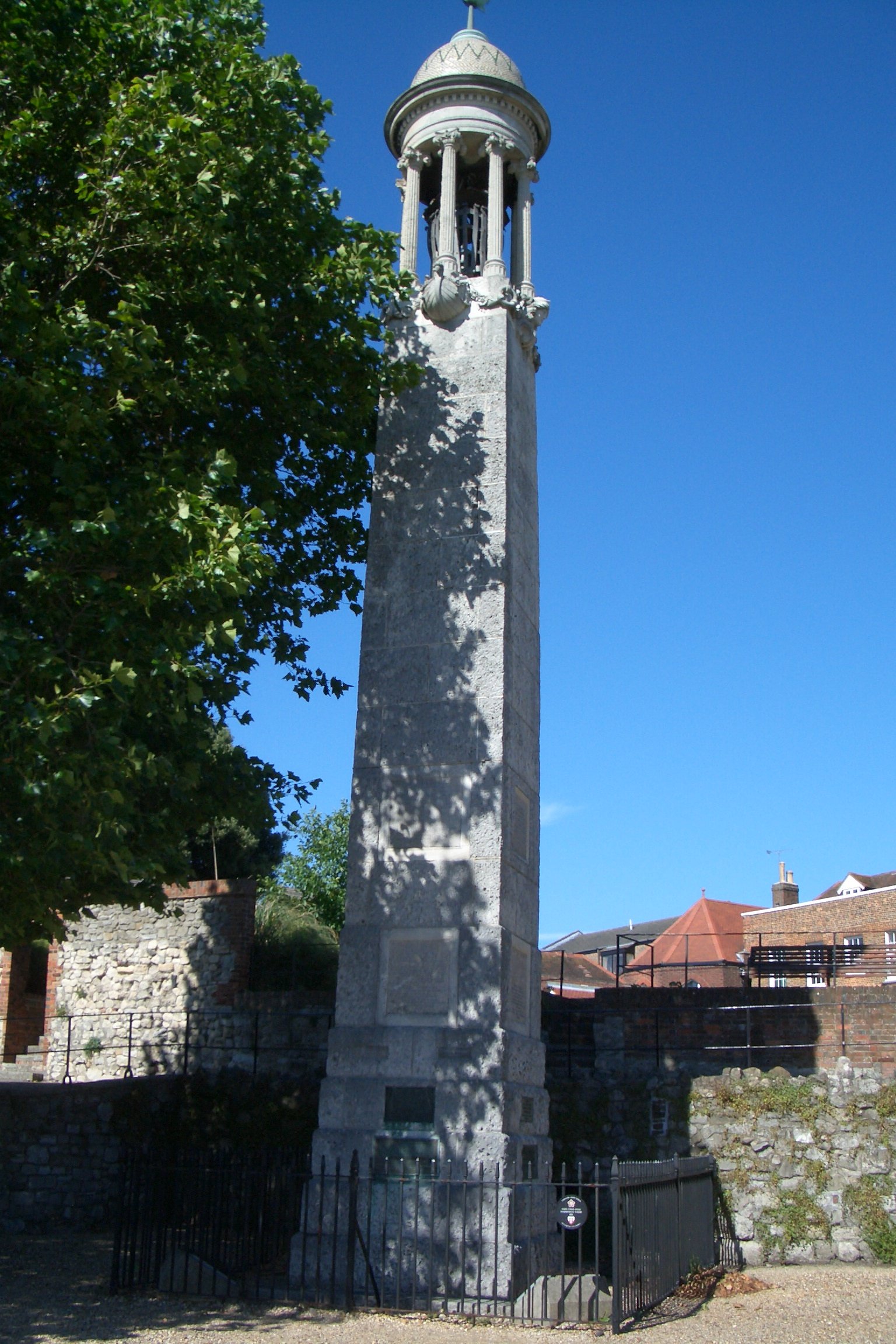 Just beyond, the wall curves back the other way, to form the southwest corner of the old city. At that point is the gate from which the pilgrims set sail in the Mayflower. A tall obelisk marks (or is at least close to) the spot. At the time, the River Test came right up to the base of the walls, so ships (or at least their small boats) really could leave from there; now it's a couple of hundred yards away. Some of Henry V's troops set sail from the same spot, on their way to the Battle of Agincourt (you know, "Once more into the breach, dear friends, . . . . Gentlemen now abed in England . . . hold their manhood cheap . . . curse their fates they were not here . . . ," etc., etc.)
Just beyond, the wall curves back the other way, to form the southwest corner of the old city. At that point is the gate from which the pilgrims set sail in the Mayflower. A tall obelisk marks (or is at least close to) the spot. At the time, the River Test came right up to the base of the walls, so ships (or at least their small boats) really could leave from there; now it's a couple of hundred yards away. Some of Henry V's troops set sail from the same spot, on their way to the Battle of Agincourt (you know, "Once more into the breach, dear friends, . . . . Gentlemen now abed in England . . . hold their manhood cheap . . . curse their fates they were not here . . . ," etc., etc.)
The original plaque on the Mayflower monument seems to commemorate mainly John Alden, a Southampton resident who joined the Mayflower expedition, although he wasn't part of the freedom-of-religion thing (the rest of the pilgrims were from elsewhere and had been moving around as a group, a step ahead of the religion police). He had inherited a bunch of debts from his father, and the expedition needed a qualified cooper to look after its barrel stores, so he signed on and sailed away. Since the monument went up, various descendents of Mayflower families have added other commemorative plaques.
The wall walk, and various branches from it, includes many other monuments, museum, and whatnot (e.g., the Tudor House Museum, the Medieval merchant's house, the God's House Tower, Jane Austen's house (she lived in Southampton for two years), the ruins of Holyrood Church (built in 1320, bombed in 1940), the wine vaults of the medieval mayor's house) of which I had time for only a portion.
In the evening, we walked back down to the National Oceanography Center for a buffet dinner in the canteen and various movies. Several research groups had brought video presentations of one sort of another, but the feature presentation was rough cuts from the upcoming second series of the BBC's "The Planet." We haven't seen the first series yet, but the clips from it were spectacular. The rough cuts from the new, as-yet-unreleased series were absolutely eye-popping. They used an assortment of ultra-low-light, ultra-high-speed, and ultra-long-telephoto cameras to record stuff you just wouldn't believe. The great white shark sequences alone could give you nightmares for days!
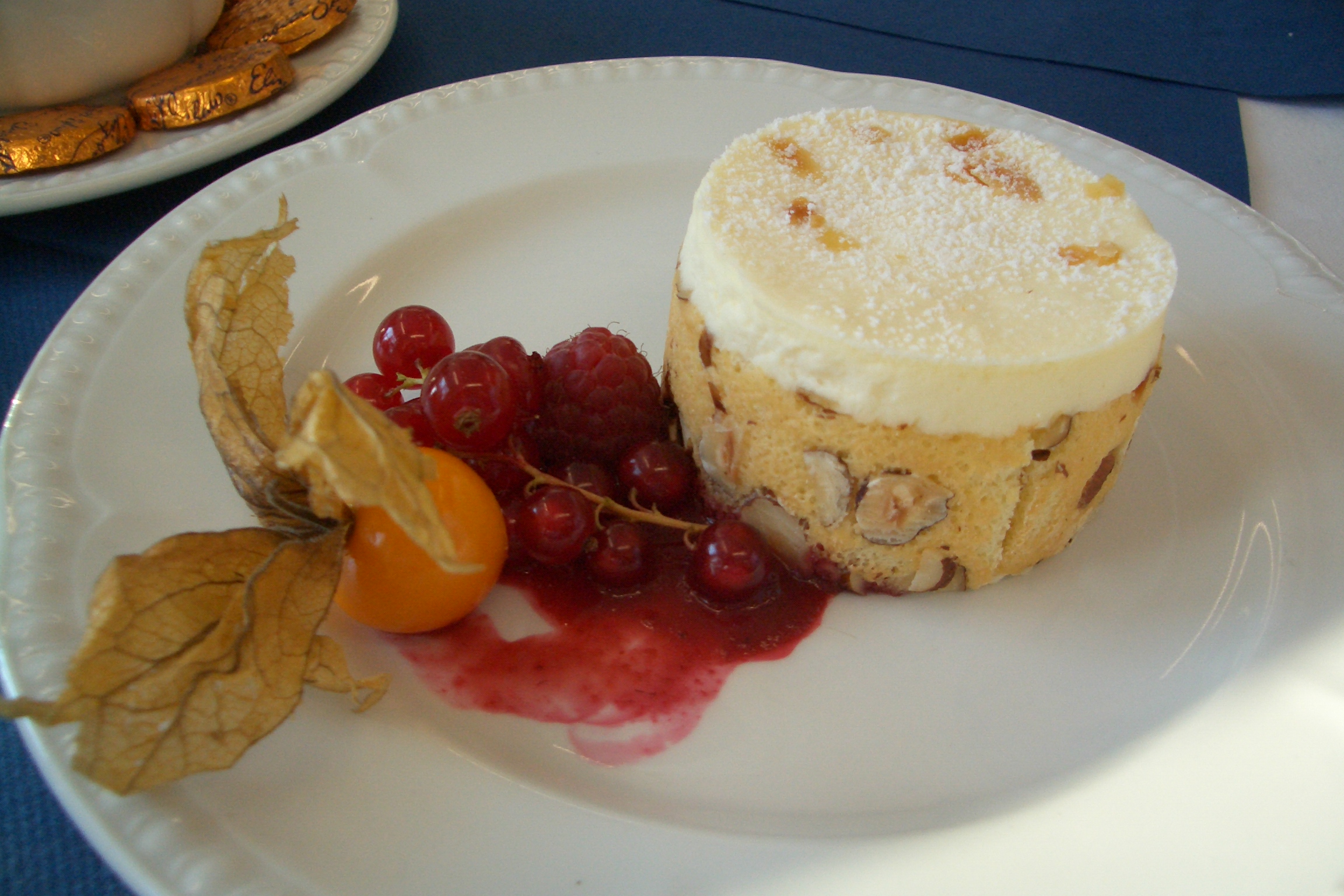 The dinner was good—much better than the one the first night. Pork stroganoff, beef and mushroom pie, cheese tortellini baked in a cream sauce. Fresh vegetables. Good bread. My dessert was especially good—a hazelnut and almond cake ring filled with lemon mousse and garnished with fresh fruit and fruit purée. The foil-wrapped disks are mint-flavored chocolates surrounding the sugar bowl on each table.
The dinner was good—much better than the one the first night. Pork stroganoff, beef and mushroom pie, cheese tortellini baked in a cream sauce. Fresh vegetables. Good bread. My dessert was especially good—a hazelnut and almond cake ring filled with lemon mousse and garnished with fresh fruit and fruit purée. The foil-wrapped disks are mint-flavored chocolates surrounding the sugar bowl on each table.
previous entry List of Entries next entry
 During the afternoon, I walked part of the old Southampton city walls, almost half of which are still standing (in isolated segments of various lengths). Southampton was built on the peninsula between the rivers Itchen and Test, where they meet to form Southampton Water (the estuary that in turn empties into the Solent, the strait between the mainland and the Isle of Wight). The walled city was roughly rectangular, its long axis running north and south. I started at the Bargate, originally in the middle of the landward end. It now marks the spot at which the pedestrian High Street (within the old town) becomes the traffic-bearing Above Bar Street (north of the old town). This view is of the north (outward) face of the gate. To the right of the picture, a set of modern stairs leads to the walkway along the top of the walls, where this statue of John le Fleming (1295-1336), an early mayor of the city, looks northward over the wall.
During the afternoon, I walked part of the old Southampton city walls, almost half of which are still standing (in isolated segments of various lengths). Southampton was built on the peninsula between the rivers Itchen and Test, where they meet to form Southampton Water (the estuary that in turn empties into the Solent, the strait between the mainland and the Isle of Wight). The walled city was roughly rectangular, its long axis running north and south. I started at the Bargate, originally in the middle of the landward end. It now marks the spot at which the pedestrian High Street (within the old town) becomes the traffic-bearing Above Bar Street (north of the old town). This view is of the north (outward) face of the gate. To the right of the picture, a set of modern stairs leads to the walkway along the top of the walls, where this statue of John le Fleming (1295-1336), an early mayor of the city, looks northward over the wall.
 The western stretch of the wall is the most complete. In this photo from the tower at the northwest corner, you can see it stretching away parallel to the road until it disappears around the curve in the distance.
The western stretch of the wall is the most complete. In this photo from the tower at the northwest corner, you can see it stretching away parallel to the road until it disappears around the curve in the distance.
 Just beyond, the wall curves back the other way, to form the southwest corner of the old city. At that point is the gate from which the pilgrims set sail in the Mayflower. A tall obelisk marks (or is at least close to) the spot. At the time, the River Test came right up to the base of the walls, so ships (or at least their small boats) really could leave from there; now it's a couple of hundred yards away. Some of Henry V's troops set sail from the same spot, on their way to the Battle of Agincourt (you know, "Once more into the breach, dear friends, . . . . Gentlemen now abed in England . . . hold their manhood cheap . . . curse their fates they were not here . . . ," etc., etc.)
Just beyond, the wall curves back the other way, to form the southwest corner of the old city. At that point is the gate from which the pilgrims set sail in the Mayflower. A tall obelisk marks (or is at least close to) the spot. At the time, the River Test came right up to the base of the walls, so ships (or at least their small boats) really could leave from there; now it's a couple of hundred yards away. Some of Henry V's troops set sail from the same spot, on their way to the Battle of Agincourt (you know, "Once more into the breach, dear friends, . . . . Gentlemen now abed in England . . . hold their manhood cheap . . . curse their fates they were not here . . . ," etc., etc.) The dinner was good—much better than the one the first night. Pork stroganoff, beef and mushroom pie, cheese tortellini baked in a cream sauce. Fresh vegetables. Good bread. My dessert was especially good—a hazelnut and almond cake ring filled with lemon mousse and garnished with fresh fruit and fruit purée. The foil-wrapped disks are mint-flavored chocolates surrounding the sugar bowl on each table.
The dinner was good—much better than the one the first night. Pork stroganoff, beef and mushroom pie, cheese tortellini baked in a cream sauce. Fresh vegetables. Good bread. My dessert was especially good—a hazelnut and almond cake ring filled with lemon mousse and garnished with fresh fruit and fruit purée. The foil-wrapped disks are mint-flavored chocolates surrounding the sugar bowl on each table.